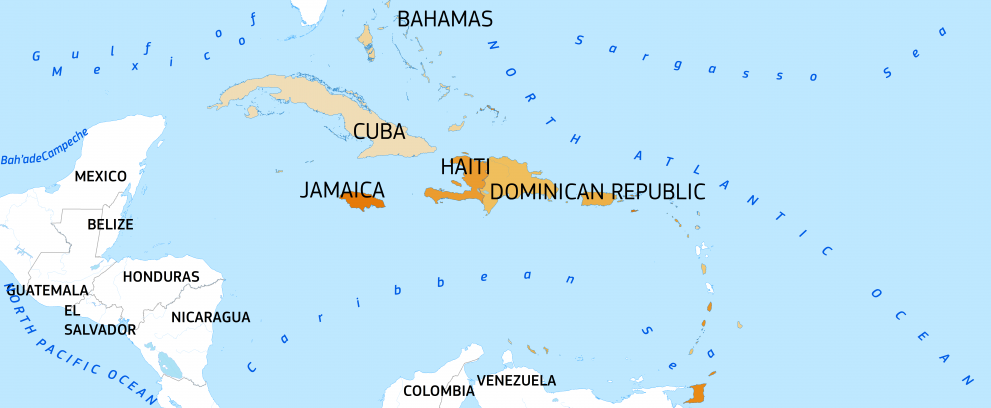Introduction
The Caribbean is the second most disaster-prone region in the world, regularly hit by disasters. Its Small Islands Developing States are increasingly vulnerable to climatic events, which are becoming more intense, unpredictable, and frequent, resulting largely from the impacts of climate change.
Along with heightened exposure to natural hazards and decreased resilience to cope with these increased number of risks, the Caribbean region continues to experience a large volume of population movement and displacement. The latter is due to exacerbated economic conditions, violence, and worsening humanitarian contexts.
What are the needs?
Due to external factors like ongoing conflicts and internal factors like reduced food import capacities, most countries in the Caribbean continue to experience unprecedented price hikes in food, inputs, and energy. The Dominican Republic, Haiti and Cuba are the countries in the region with the highest prevalence of insufficient food consumption.
Despite continuous efforts to strengthen national and regional disaster management systems, capacities are constantly challenged by the unpredictability, frequency and magnitude of events. In addition, the Caribbean coastal areas are witnessing a 10% increase in sea level rise, above the global average. Coastal erosion, limited resources in protecting and maintaining sea defences and waterfronts, and marine resource degradation pose significant challenges to Small Island Developing States.
So far, 2024 has been characterised by an unprecedented early and devastating hurricane season, which has recorded 18 named storms; 9 of these storms became hurricanes and 5 were classified as major hurricanes (category 3 or higher). In July, a category 5 hurricane Beryl hit multiple countries including Grenada, Saint Vincent and Grenadines, Barbados, and Jamaica. Between October and November, in less than 3 weeks, Cuba was struck by 2 hurricanes (Oscar and Rafael), in addition to 2 earthquakes of 5.9 and 6.8 magnitude respectively.
This year has also seen an increased number of displacement and movement of people across the Caribbean, in particular for Haitians, Cubans and Venezuelans fleeing their countries, because of insecurity or worsened social and economic conditions.
In several other parts of the Caribbean, food insecurity continues to be a concerning factor, due to the slow erosion of livelihoods and coping capacities.

How are we helping?
Since 1994, the EU has provided around €207 million in humanitarian aid to the Caribbean (excluding Haiti). This has supported disaster preparedness efforts and has addressed the changing humanitarian context.
In 2024, the EU allocated an additional €2.1 million to increase the humanitarian scope and maintain protection and education assistance in key countries where there is a large volume of refugee caseloads and were also affected by a deteriorating crisis, such as the Dominican Republic.
Also in 2024, €500,000 were allocated to disaster preparedness in the Dominican Republic, to complement existing funding and to cover some key gaps in their early warning systems. Due to the biannual allocation of the disaster preparedness budget line, the Caribbean will receive dedicated funding in 2025.
During 2024, the EU released humanitarian aid in response to several emergencies in Cuba. In April, the EU contributed with €200,000 to the Disaster Response Emergency Fund (DREF) of the International Federation of Red Cross and Red Crescent Societies (IFRC), to support Cuba's response to the flash floods that affected 4 of its provinces. The funding supported the distribution of hygiene kits, mattress, kitchen sets, mosquito nets, tarpaulins, and shelter tool kits.
Later in July, the EU provided €500,000 to an action responding to the health crisis in Cuba. This action, implemented by PAHO, UNFPA and UNICEF, addressed the most urgent needs of children, adolescents, and women of reproductive age.
In November, in response to hurricane Oscar in Cuba, the EU mobilised €400,000 to support food and medical assistance in Guantanamo. The EU funded an air bridge operation comprising 5 humanitarian cargo flights that transported 107 tons of aid, including the European Humanitarian Response Capacity’s stocks based in Panama. Additionally, the EU allocated €200,000 to the IFRC. Following the impact of hurricane Rafael and the 2 earthquakes that affected the country later on that month, the EU approved another €2.7 million.
This active hurricane season heavily impacted also other countries in the Caribbean. Following the impact of Hurricane Beryl in July 2024, the EU allocated €450,000 to WFP to respond to the most pressing needs in Grenada and Saint Vincent and the Grenadines. The EU also contributed €200,000 to the IFRC’s DREF emergency operation in Jamaica, Grenada and Saint Vincent and the Grenadines.
On 15 May 2024, the EU signed a Memorandum of Understanding on integrated Disaster Risk Management with the Latin America and Caribbean region. The first such agreement of its kind, it provides an important framework for enhanced region-to-region collaboration. 3 regional disaster management agencies, including the Caribbean Disaster Emergency Management Agency (CDEMA), as well as 3 individual countries, (Mexico, Cuba and Chile), have signed as participants to the Memorandum.
Last updated: 26/11/2024
Facts & figures
Around 216,000 Venezuelan refugees and asylum seekers live in the Caribbean (predominantly in the Dominican Republic and Trinidad and Tobago) facing protection risks.
More than 1 million vulnerable people of Haitian origin live in extreme difficult conditions in the Dominican Republic. In 2024 alone, the reported number of deportations out of the country reached 147,000 cases so far, including vulnerable women and children.
EU humanitarian funding:
€207 million since 1994 (funding excluding Haiti*)

